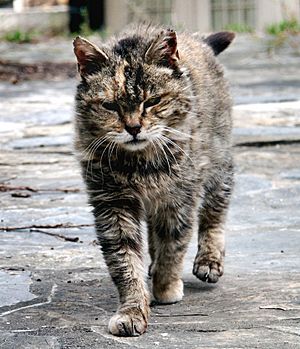Farm cat facts for kids
A farm cat, also known as a barn cat, is a domestic cat. These cats are usually a mix of breeds, like a Domestic short-haired cat. They live mostly outdoors on farms or ranches. They often find shelter in barns or other farm buildings. Farm cats are great at hunting vermin, like mice and rats. They also catch other small animals that live near farm buildings and fields.
Long ago, people might have first tamed cats to help protect their food. Cats would keep rodents from eating or spoiling grain crops. Today, farm cats are still very useful. They help control unwanted pests on farms, ranches, and even in greenhouses. These pests could otherwise damage or eat crops, like grain or animal feed. Farm cats hunt rodents, and their scent can even keep more rodents away.
Contents
History of Farm Cats
Cats have been living with humans for a very long time. Scientists believe cats were first tamed around 7500 BC. This happened because people needed to protect their stored grain. Cats were perfect for keeping rodents away from these important food supplies.
Life as a Farm Cat
Farm cats live in many different ways. Some are quite wild, called feral cats. They have very little contact with humans. They usually don't get vet care and find all their own food. These cats rely only on hunting mice and rats. Because they hunt a lot and don't always have enough food, they can be thinner than house cats. They also tend to live shorter lives.
Farm Cats and People
Other farm cats are more like part-time pets. They live both indoors and outdoors. These cats can roam freely but are also allowed inside for food. They get regular cat food and often see a vet. Some farm cats live outdoors all the time but are still friendly to humans. They might also get basic vet care.
Dangers for Outdoor Cats
Living outdoors has some risks for farm cats. The animals they hunt can carry parasites and diseases. Cats can also get hurt in different ways, like being hit by cars. Other animals can also hunt cats. For example, raccoons, owls, and coyotes might prey on them.
Feeding Farm Cats
Some farm owners give their outdoor cats cat food. They do this to encourage the cats to stay. Or they might just want to be kind to the animals. Other owners choose not to feed their outdoor cats. They believe that if cats get extra food, they won't hunt rodents as much. If cats don't get extra food, they might hunt most of the local rodents. Then they might move on to find more food. However, feeding outdoor cats can sometimes attract other animals like skunks or raccoons.
Where Farm Cats Come From
Farm cats can come from different places. Sometimes, stray or abandoned cats move onto a farm. They find food there, like in haystacks or barns with stored crops. Other times, farm owners get cats specifically for rodent control. Some animal shelters have special programs. They re-home spayed or neutered feral cats to barns, warehouses, or stores. These "Working Cat" or "Barn Buddy" programs are popular in cities with rat problems, like Chicago.
Controlling Farm Cat Populations
If there are enough wild female farm cats, their population can grow on its own. The females make homes in barns and have many litters of kittens. Male cats might stay nearby if there's plenty of food. However, they often roam over a larger area. Farm cat groups can sometimes have problems with inbreeding. This happens when cats in a closed group mate with their siblings, parents, or kittens.
Spaying (for females) and neutering (for males) helps a lot. It stops unwanted litters and too many cats. It also prevents inbreeding. In some cases, wild cats are trapped. Then they are spayed or neutered and released back to their territory. This helps keep their area claimed and stops new, fertile stray cats from moving in.
If farm cats get extra food or if there are many rodents, new stray cats might move in. This can make up for any cats lost to predators or disease. But if cats don't get extra food, especially where there are many predators, the farm cat population might disappear. This can happen if there are few stray cats nearby and not many breeding cats. Predators, accidents, diseases, parasites, and hunger can all reduce their numbers. Often, especially when food is provided, there can be too many cats. Then, most losses happen because of disease or accidents, with predators playing a smaller role.
See also
 In Spanish: Gato de granja para niños
In Spanish: Gato de granja para niños



